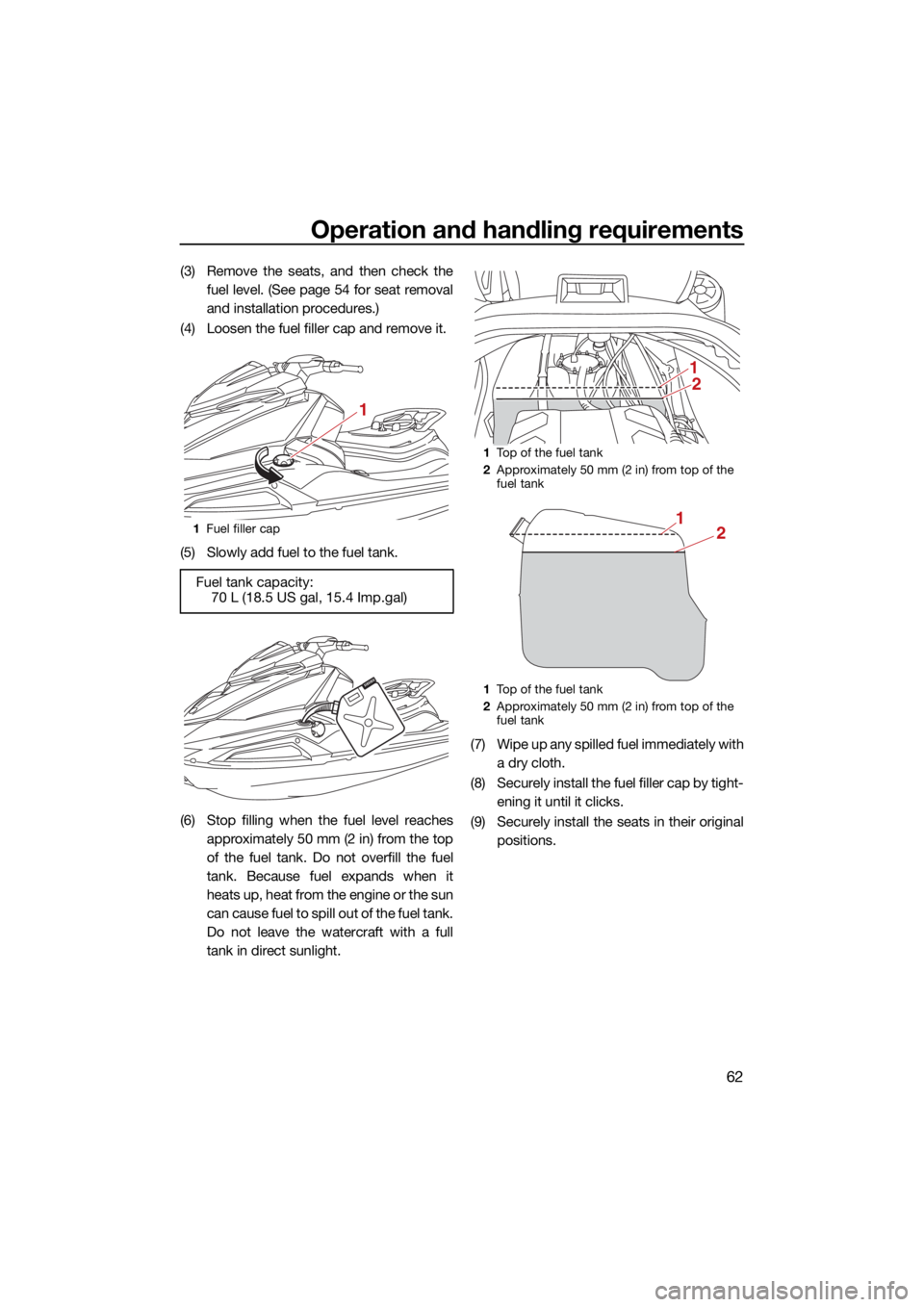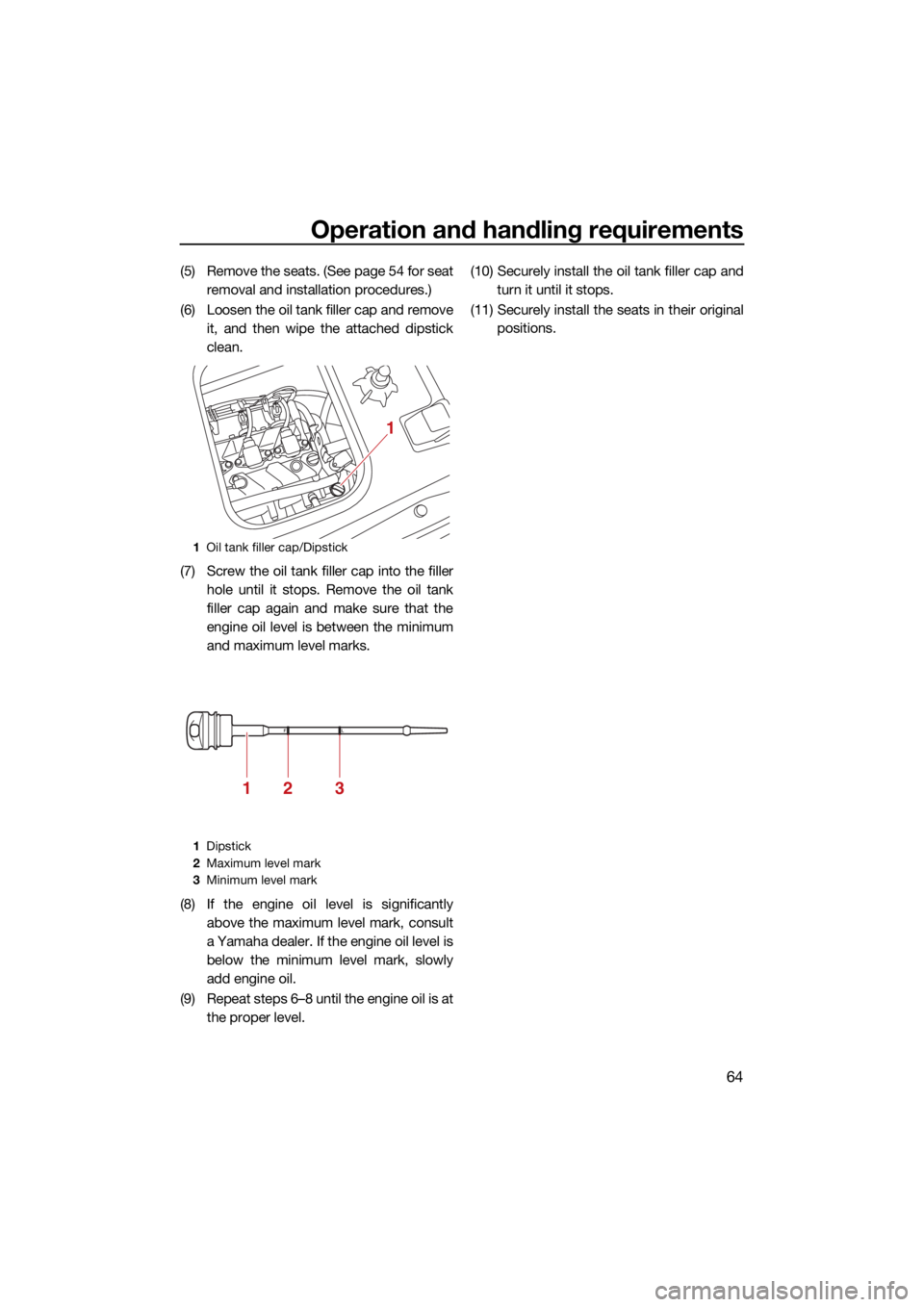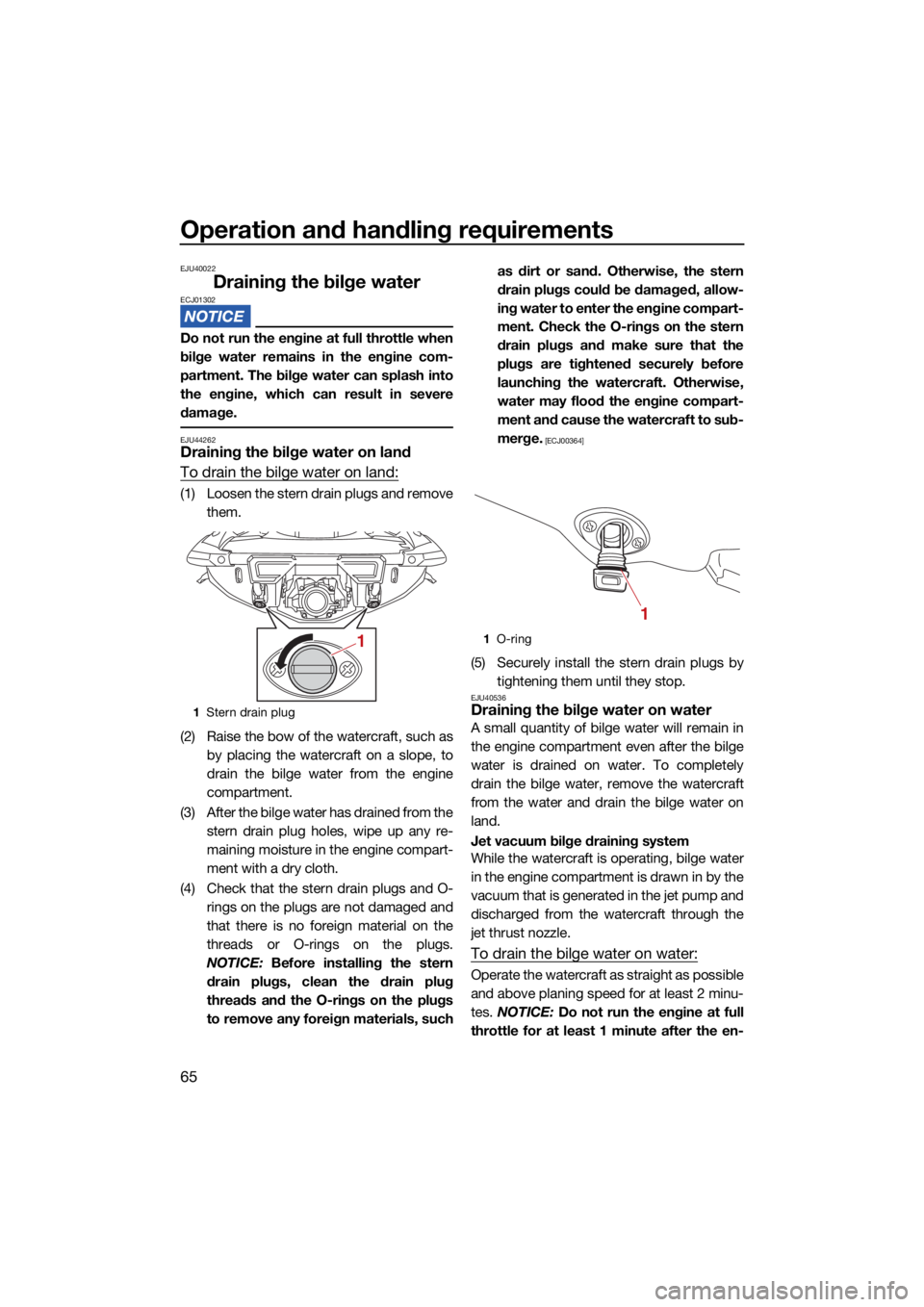ECU YAMAHA VX-C 2022 User Guide
[x] Cancel search | Manufacturer: YAMAHA, Model Year: 2022, Model line: VX-C, Model: YAMAHA VX-C 2022Pages: 122, PDF Size: 5.65 MB
Page 69 of 122

Equipment operation
60
(3) Securely install the rear seat in its originalposition.
EJU46030Fire extinguisher holder and cover
The fire extinguisher holder and cover are lo-
cated in the bow storage compartment.
To use the fire extinguisher holder and
cover:
(1) Pull the hood latch rearward, and then liftup the rear of the hood.
(2) Unhook the band and remove the fire ex- tinguisher from the fire extinguisher cov-
er.
(3) Place the fire extinguisher in the fire ex- tinguisher cover, and then securely fas-
ten the fire extinguisher with the band.
(4) Push the rear of the hood down to se- curely lock it in place. Make sure that the hood is securely closed before using the
watercraft.
1
Hood latch
1 Fire extinguisher holder and cover
2 Band
1
2
1
UF4N71E0.book Page 60 Thursday, August 5, 2021 11:58 AM
Page 71 of 122

Operation and handling requirements
62
(3) Remove the seats, and then check thefuel level. (See page 54 for seat removal
and installation procedures.)
(4) Loosen the fuel filler cap and remove it.
(5) Slowly add fuel to the fuel tank.
(6) Stop filling when the fuel level reaches approximately 50 mm (2 in) from the top
of the fuel tank. Do not overfill the fuel
tank. Because fuel expands when it
heats up, heat from the engine or the sun
can cause fuel to spill out of the fuel tank.
Do not leave the watercraft with a full
tank in direct sunlight. (7) Wipe up any spilled fuel immediately with
a dry cloth.
(8) Securely install the fuel filler cap by tight- ening it until it clicks.
(9) Securely install the seats in their original positions.
1Fuel filler cap
Fuel tank capacity:
70 L (18.5 US gal, 15.4 Imp.gal)
1
1Top of the fuel tank
2 Approximately 50 mm (2 in) from top of the
fuel tank
1 Top of the fuel tank
2 Approximately 50 mm (2 in) from top of the
fuel tank
1
2
21
UF4N71E0.book Page 62 Thursday, August 5, 2021 11:58 AM
Page 73 of 122

Operation and handling requirements
64
(5) Remove the seats. (See page 54 for seatremoval and installation procedures.)
(6) Loosen the oil tank filler cap and remove it, and then wipe the attached dipstick
clean.
(7) Screw the oil tank filler cap into the filler hole until it stops. Remove the oil tank
filler cap again and make sure that the
engine oil level is between the minimum
and maximum level marks.
(8) If the engine oil level is significantly above the maximum level mark, consult
a Yamaha dealer. If the engine oil level is
below the minimum level mark, slowly
add engine oil.
(9) Repeat steps 6–8 until the engine oil is at the proper level. (10) Securely install the oil tank filler cap and
turn it until it stops.
(11) Securely install the seats in their original positions.
1Oil tank filler cap/Dipstick
1 Dipstick
2 Maximum level mark
3 Minimum level mark
1
213
UF4N71E0.book Page 64 Thursday, August 5, 2021 11:58 AM
Page 74 of 122

Operation and handling requirements
65
EJU40022
Draining the bilge waterECJ01302
Do not run the engine at full throttle when
bilge water remains in the engine com-
partment. The bilge water can splash into
the engine, which can result in severe
damage.
EJU44262Draining the bilge water on land
To drain the bilge water on land:
(1) Loosen the stern drain plugs and removethem.
(2) Raise the bow of the watercraft, such as by placing the watercraft on a slope, to
drain the bilge water from the engine
compartment.
(3) After the bilge water has drained from the stern drain plug holes, wipe up any re-
maining moisture in the engine compart-
ment with a dry cloth.
(4) Check that the stern drain plugs and O- rings on the plugs are not damaged and
that there is no foreign material on the
threads or O-rings on the plugs.
NOTICE: Before installing the stern
drain plugs, clean the drain plug
threads and the O-rings on the plugs
to remove any foreign materials, such as dirt or sand. Otherwise, the stern
drain plugs could be damaged, allow-
ing water to enter the engine compart-
ment. Check the O-rings on the stern
drain plugs and make sure that the
plugs are tightened securely before
launching the watercraft. Otherwise,
water may flood the engine compart-
ment and cause the watercraft to sub-
merge.
[ECJ00364]
(5) Securely install the stern drain plugs by
tightening them until they stop.
EJU40536Draining the bilge water on water
A small quantity of bilge water will remain in
the engine compartment even after the bilge
water is drained on water. To completely
drain the bilge water, remove the watercraft
from the water and drain the bilge water on
land.
Jet vacuum bilge draining system
While the watercraft is operating, bilge water
in the engine compartment is drawn in by the
vacuum that is generated in the jet pump and
discharged from the watercraft through the
jet thrust nozzle.
To drain the bilge water on water:
Operate the watercraft as straight as possible
and above planing speed for at least 2 minu-
tes. NOTICE: Do not run the engine at full
throttle for at least 1 minute after the en-
1 Stern drain plug
11O-ring
1
UF4N71E0.book Page 65 Thursday, August 5, 2021 11:58 AM
Page 75 of 122
![YAMAHA VX-C 2022 User Guide Operation and handling requirements
66
gine has been restarted. Bilge water in the
engine compartment can splash into the
engine, which can result in severe dam-
age.
[ECJ00554]EJU42432
Transporting YAMAHA VX-C 2022 User Guide Operation and handling requirements
66
gine has been restarted. Bilge water in the
engine compartment can splash into the
engine, which can result in severe dam-
age.
[ECJ00554]EJU42432
Transporting](/img/51/52039/w960_52039-74.png)
Operation and handling requirements
66
gine has been restarted. Bilge water in the
engine compartment can splash into the
engine, which can result in severe dam-
age.
[ECJ00554]EJU42432
Transporting on a trailer
When transporting the watercraft on a trailer,
secure the tie downs to the trailer through the
bow eye and stern eyes.
NOTICE: Do not at-
tach ropes or tie downs to any part of the
watercraft other than the bow eye and
stern eyes to secure the watercraft to the
trailer. Otherwise, the watercraft may be
damaged. Wrap the ropes or tie downs
with towels or rags where they touch the
body of the watercraft to avoid scratches
or damage.
[ECJ02150]
UF4N71E0.book Page 66 Thursday, August 5, 2021 11:58 AM
Page 77 of 122

Pre-operation checks
68
EJU31984
EWJ00413
Failure to inspect or maintain the watercraft properly increases the possibility of an ac-
cident or damage to the watercraft. Do not operate the watercraft if you find any prob-
lem. If a problem cannot be corrected by the procedures provided in this manual, have
the watercraft inspected by a Yamaha dealer.
EJU41237Pre-operation checklist
Before using this watercraft, be sure to perform the checks in the following checklist.
PRE-LAUNCH CHECKS
ITEM ROUTINEPAGE
Engine compartment Ventilate the engine compartment.
Check inside the engine compartment for damage.
70
Fuel system Check the fuel system for leakage.
Check the fuel level in the fuel tank.
70
Water separator Check the water separator for water. 70
Engine unit Check the exterior of the engine unit for damage. 71
Engine oil level Check the engine oil level. 71
Bilge water Check the engine compartment for bilge water. 71
Battery Check the battery connections. 71
Steering system Check the steering system for proper operation. 71
RiDE lever (VX /
VX DELUXE /
VX CRUISER / VX LIMITED) Check the RiDE lever for proper operation.
72
Throttle lever Check the throttle lever for proper operation. 72
Yamaha Security System
(VX DELUXE /
VX CRUISER / VX LIMITED) Check the Yamaha Security System for proper op-
eration.
72
Engine shut-off cord (lan-
yard) Check the engine shut-off cord (lanyard) for dam-
age.
72
Switches VX-C:
Check the start switch, engine stop switch, and en-
gine shut-off switch for proper operation.
VX / VX DELUXE / VX CRUISER / VX LIMITED:
Check the engine start/stop switch and engine
shut-off switch for proper operation.
73
Storage compartments Check the storage compartments for damage and
water.
74
Fire extinguisher holder,
cover, and band Check the fire extinguisher holder, cover, and band
for damage.
74
Fire extinguisher Check the condition of the fire extinguisher. 74
Safety equipment Check that safety equipment meeting the applica-
ble regulations is on board.
74
UF4N71E0.book Page 68 Thursday, August 5, 2021 11:58 AM
Page 78 of 122

Pre-operation checks
69
POST-LAUNCH CHECKS
TIP
To ensure safety and reliability, pre-operation checks should be made each time the water-
craft is used.
Hull and deck Check the hull and deck for damage. 74
Jet intake Check the jet intake for damage and clogging. 74
Jet thrust nozzle and re-
verse gate (VX /
VX DELUXE /
VX CRUISER / VX LIMITED) Check the jet thrust nozzle and reverse gate for
damage.
74
Stern drain plugs Check the stern drain plugs for damage and foreign
material and check that they are securely installed.
75
Hood Check that the hood is securely closed. 75
Front and rear seats Check that the seats are securely installed. 54
ITEM ROUTINE PAGE
Cooling water pilot outlet Check that water is discharged from the cooling
water pilot outlet while the engine is running.
75
Multifunction information
center Check the multifunction information center for prop-
er operation.
76
Shift system (VX /
VX DELUXE /
VX CRUISER / VX LIMITED) Check the shift system for proper operation. 76
Engine idling speed Check the engine idling speed. 76
ITEM ROUTINE PAGE
UF4N71E0.book Page 69 Thursday, August 5, 2021 11:58 AM
Page 79 of 122

Pre-operation checks
70
EJU32282
Pre-operation check pointsEJU40099Pre-launch checks
Perform the pre-launch checks in the pre-op-
eration checklist while the watercraft is on
land.
To perform the pre-launch checks:
(1) Remove the seats and seat storagecompartment. (See page 54 for seat re-
moval and installation procedures and
page 59 for information on the seat stor-
age compartment.)
(2) Perform the checks and make sure that there are no malfunctioning items or oth-
er problems.
(3) After completing these checks, securely install the seat storage compartment and
seats in their original positions.
EJU32334Engine compartment checkEWJ00462
Failure to ventilate the engine compart-
ment could result in a fire or explosion. Do
not start the engine if there is a fuel leak.
Ventilate the engine compartment. Leave the
engine compartment open for a few minutes
to allow any fuel vapors to escape.
Make sure that there is no damage inside the
engine compartment.
EJU34215Fuel system checksEWJ00382
Leaking fuel can result in fire or explosion.
Check for fuel leakage regularly.
If any fuel leakage is found, the fuel sys-
tem must be repaired by a qualified me-
chanic. Improper repairs can make the
watercraft unsafe to operate.
Make sure that there is no damage, leakage,
or other problem in the fuel system.
Check:
Fuel filler cap and seal for damage
Fuel tank for damage and leakage
Fuel hoses and joints for damage and leak-
age
Fuel tank breather hose for damage and
leakage
EJU36875Fuel level check
Check the fuel level in the fuel tank.
Add fuel if necessary. (See page 61 for infor-
mation on filling the fuel tank.)
EJU32424Water separator check
Make sure that no water has collected in the
water separator. If water has collected in the
water separator, drain it. (See page 29 for in-
formation on draining the water separator.)
1Water separator
1
UF4N71E0.book Page 70 Thursday, August 5, 2021 11:58 AM
Page 80 of 122

Pre-operation checks
71
EJU40182Engine unit check
Check the exterior of the engine unit for dam-
age or other problem.
EJU41561Engine oil level check
Make sure that the engine oil level is between
the minimum and maximum level marks on
the dipstick attached to the oil tank filler cap.
(See page 63 for information on checking the
engine oil level.)
EJU32456Bilge water check
Make sure that no bilge water has collected in
the engine compartment. If bilge water has
collected in the engine compartment, drain it.
(See page 65 for information on draining the
bilge water.)
EJU32488Battery checks
Make sure that the battery terminals are not
damaged and that the battery leads are con-
nected properly. WARNING! Never operate
the watercraft if the battery does not have
sufficient power to start the engine or if it
shows any other signs of decreased pow-
er. Loss of battery power may leave you
stranded.
[EWJ01242]
Make sure that the battery is securely held in
place.
EJU32614Steering system checks
Turn the handlebars to the right and left sev-
eral times to make sure that operation is
smooth and unrestricted throughout the
whole range, and that the free play is not ex-
cessive.
1 Oil tank filler cap/Dipstick
1 Dipstick
2 Maximum level mark
3 Minimum level mark
1
213
1Negative (–) battery terminal: Black lead
2 Positive (+) battery terminal: Red lead
2
1
UF4N71E0.book Page 71 Thursday, August 5, 2021 11:58 AM
Page 81 of 122

Pre-operation checks
72
Turn the handlebars as far as possible to the
right and left to make sure that the jet thrust
nozzle moves as the handlebars are turned,
and that there is no difference between the
right and left fully turned positions of the jet
thrust nozzle.
EJU43213RiDE lever checks (VX / VX DELUXE /
VX CRUISER / VX LIMITED)
Operate the RiDE lever several times to make
sure that operation is smooth throughout the
whole range. Also, make sure that the RiDE
lever returns automatically to its fully closed
position when released.
EJU42181Throttle lever checks
Operate the throttle lever several times to
make sure that operation is smooth through-
out the whole range. Also, make sure that the
throttle lever returns automatically to its fully
closed (idle) position when released.
EJU45351Yamaha Security System check (VX DELUXE / VX CRUISER / VX LIMITED)
Make sure that the Yamaha Security System
operates properly. (See page 25 for Yamaha
Security System setting procedures.)
EJU32666Engine shut-off cord (lanyard) check
Make sure that the engine shut-off cord (lan-
yard) is not damaged. If the cord is damaged,
replace it. WARNING! Never try to repair
the engine shut-off cord (lanyard) or tie it
together. The engine shut-off cord (lan-
yard) may not pull free when the operator
falls off, allowing the watercraft to conti-
nue to run and cause an accident.
[EWJ01222]
Difference between fully turned posi-
tions of jet thrust nozzle (distances A
and B): Maximum 5 mm (0.20 in)
UF4N71E0.book Page 72 Thursday, August 5, 2021 11:58 AM